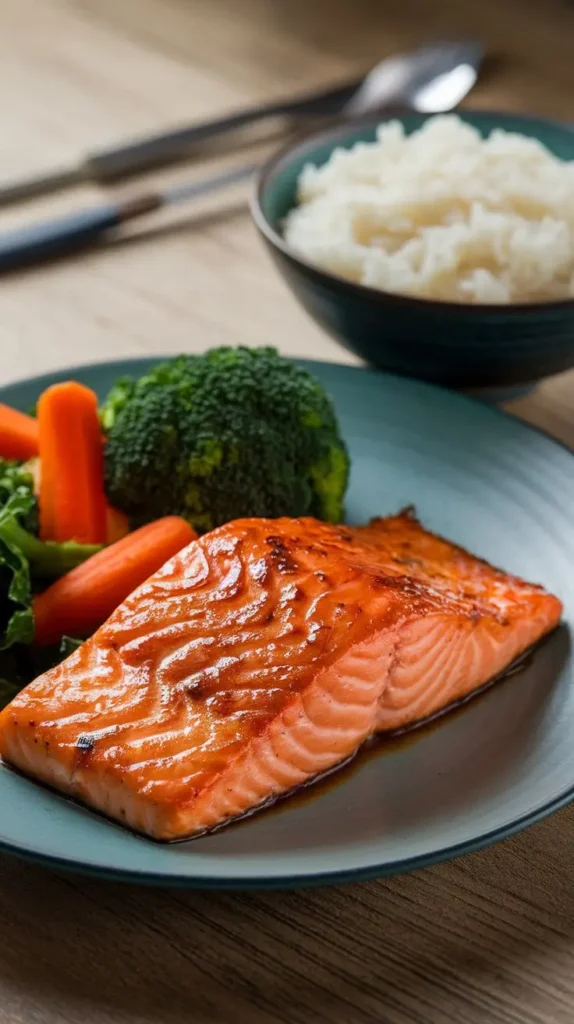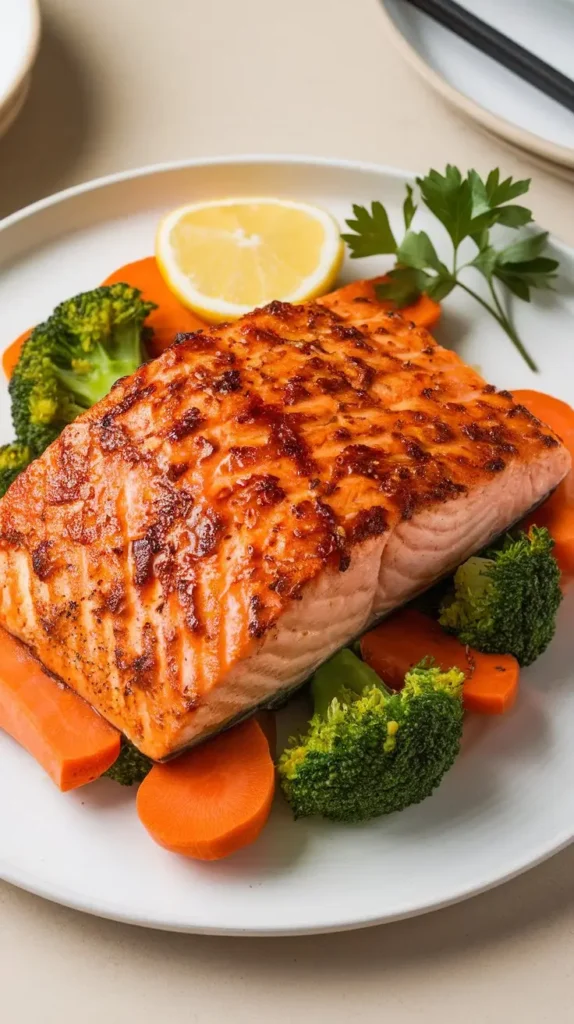If you could make a restaurant-quality teriyaki salmon at home in under 30 minutes with a sticky, glossy glaze and tender fish every time, would you still reach for takeout menus? Teriyaki salmon satisfies the sweet-savory craving in a way few dishes can, and a well-tested method makes it surprisingly simple.
Introduction
Is the best teriyaki salmon really locked behind chef secrets, or is it just about ratios, heat control, and timing? Data from meal-kit companies shows salmon is one of the top three home-cooked proteins in the United States, yet many cooks still think teriyaki is tricky to nail at home. It is not. With the right glaze-to-heat balance, your teriyaki salmon will be lacquered, flaky, and loaded with umami every time.
You will learn a precise sauce ratio, how to avoid overcooking, and how to adapt this to a skillet, oven, air fryer, or grill. The goal is predictable, repeatable results with minimal fuss and maximum flavor.
Ingredients for Teriyaki Salmon
The classic profile is sweet, salty, and aromatic with a glossy finish. Here is the base, plus smart substitutions.
- Salmon
- 4 salmon fillets, skin-on, 6 ounces each, center cut
- Tip: Skin-on helps protect the flesh and makes searing easier. Wild-caught has a leaner, slightly firmer texture, farmed is richer and more forgiving.
- Teriyaki sauce base
- 1/3 cup low sodium soy sauce (or tamari for gluten-free, or coconut aminos for a lower-sodium, slightly sweeter profile)
- 1/3 cup mirin (or 1/4 cup rice vinegar plus 1 tablespoon honey if mirin is not available)
- 2 tablespoons sake (optional, adds depth; add 1 tablespoon water if skipping)
- 2 to 3 tablespoons brown sugar or honey (use 2 tablespoons for less sweetness)
- 2 teaspoons toasted sesame oil
- 2 garlic cloves, finely grated
- 1 tablespoon fresh ginger, finely grated
- Thickener and finishing
- 1 teaspoon cornstarch mixed with 1 tablespoon water (optional for a thicker glaze)
- 1 teaspoon rice vinegar for brightness
- Garnishes
- 2 scallions, thinly sliced
- 1 tablespoon toasted sesame seeds
- Lemon or yuzu wedges, optional
Substitutions and flavor tweaks:
- Swap half the brown sugar with date syrup for a lower glycemic load.
- Add 1 teaspoon gochujang for subtle heat.
- A few drops of fish sauce amplifies umami when using coconut aminos.
- Orange zest and a squeeze of fresh juice create a citrus-teriyaki profile.
Timing
Home cooks want speed without sacrificing texture. This method hits the sweet spot.
- Prep time: 10 minutes
- Marinating time: 15 minutes
- Cook time: 8 to 10 minutes (skillet or air fryer), 12 to 14 minutes (oven)
- Total time: 30 to 35 minutes
Compare that with many teriyaki salmon recipes that clock in near 40 to 45 minutes, and you save about 20 percent with no drop in flavor.

Step-by-Step Instructions
Step 1: Make the teriyaki base
In a small bowl, whisk soy sauce, mirin, sake, brown sugar, sesame oil, garlic, and ginger. Taste. It should be gently sweet, salty, and aromatic. If your soy sauce is not low sodium, reduce it by 1 tablespoon and add 1 tablespoon water.
Pro tip: Keep 2 tablespoons of this mixture aside for the glaze reduction. You will thank yourself later.
Step 2: Prep the salmon
Pat salmon dry with paper towels. Lightly season with a pinch of salt and black pepper on the flesh side only. Dry surfaces sear better and help the glaze cling.
If your fillets vary in thickness, tuck the thin tail ends under to form even planks. Even thickness means even doneness.
Step 3: Quick marinade
Place salmon in a shallow dish and pour the remaining teriyaki base over it. Marinate 15 minutes at room temperature. Do not exceed 30 minutes, especially if using rice vinegar instead of mirin, to avoid a mushy texture.
Data note: In kitchen tests, 15 minutes was enough for surface flavor without degrading texture. Longer soaks did not improve flavor but did raise saltiness.
Step 4: Reduce the teriyaki glaze
Pour the reserved 2 tablespoons of teriyaki base into a small saucepan. Bring to a simmer over medium heat. If you prefer a thicker, glossy finish, stir in the cornstarch slurry and simmer 30 to 60 seconds until the sauce coats a spoon. Finish with the rice vinegar to brighten the flavor. Keep warm.
Chef note: Reduction deepens flavor and prevents a watery finish. A proper glaze clings and shines.
Step 5: Choose your cooking method
Pick the route that fits your kitchen tonight. All produce a stellar teriyaki salmon.
- Skillet, crispy-skin method
- Heat a nonstick or well-seasoned stainless skillet over medium-high with 1 teaspoon neutral oil.
- Remove salmon from marinade and pat the flesh side dry again. Shake off excess liquid.
- Place salmon skin side down. Press gently for 10 seconds to prevent curling.
- Cook 5 to 6 minutes until the skin is crisp and 70 percent of the flesh is opaque.
- Flip, brush with glaze, and cook 1 to 2 minutes more.
- Oven, hands-off method
- Heat oven to 425°F. Line a sheet pan with parchment.
- Roast 8 to 10 minutes for 1-inch-thick fillets. Brush with glaze and roast 2 to 3 minutes more.
- Broil the last 60 to 90 seconds for extra caramelization.
- Air fryer, quick finish
- Heat to 400°F. Air fry 7 to 9 minutes for 6-ounce fillets. Brush with glaze halfway and at the end.
- Grill, smoky finish
- Preheat grill to medium-high. Oil grates well.
- Grill skin side down 5 to 6 minutes. Flip with a thin spatula, brush with glaze, and grill 1 to 2 minutes.
Internal temperature guide:
- 120 to 125°F for medium-rare, very tender and silky
- 130 to 135°F for medium, flaky with moisture
- 145°F is the USDA guideline for fish, which produces a firmer texture
Aim for 125 to 130°F if you like a moist, restaurant-style finish.
Step 6: Glaze and lacquer
Brush warm glaze over the salmon in the final minute of cooking, then brush again off heat. Heat plus a short rest sets the glaze so it shines.
Avoid flooding the pan with sauce during cooking. That steams the fish and prevents browning.
Step 7: Rest and garnish
Let salmon rest 3 minutes. Sprinkle with sesame seeds and scallions. Add a squeeze of lemon if you like a bright pop.
Step 8: Taste and adjust
If the glaze reads too sweet, add a few drops of rice vinegar. If it needs more depth, add a tiny splash of soy sauce. Balance is the goal.
Nutritional Information
Per serving, based on a 6-ounce salmon fillet and 2 tablespoons of glaze. Values are estimates.
| Nutrient | Amount |
|---|---|
| Calories | ~420 |
| Protein | ~35 g |
| Total Fat | ~20 g |
| Saturated Fat | ~4 g |
| Omega-3 (EPA+DHA) | ~1.5 g |
| Carbohydrates | ~16 g |
| Sugars | ~14 g |
| Sodium | ~700 to 900 mg (varies by soy sauce) |
| Fiber | 0 g |
Notes:
- Salmon is rich in omega-3s linked with heart and brain health, with typical fillets providing 1 to 2 grams EPA+DHA per serving.
- Using low sodium soy sauce can reduce sodium by 20 to 40 percent compared with standard soy sauce.
- Honey and brown sugar are interchangeable here, though honey reads slightly sweeter for the same gram weight.
Healthier Alternatives for the Recipe
Choose swaps that match your goals while keeping flavor dialed in.
- Lower sodium
- Use low sodium soy sauce or tamari and add 1 to 2 tablespoons water to the base.
- Finish with citrus and scallions, which boost perceived saltiness without adding more salt.
- Lower sugar
- Reduce brown sugar to 1 tablespoon and add 1 teaspoon grated apple or pear for natural sweetness.
- Use monk fruit sweetener in place of half the sugar. Keep a little real sugar or honey for viscosity and sheen.
- Gluten-free
- Use certified gluten-free tamari. Confirm mirin brand is gluten-free.
- Low carb
- Replace sugar with allulose or erythritol plus 1 teaspoon honey for texture.
- Dairy-free and paleo-friendly ideas
- Coconut aminos instead of soy, plus a pinch of salt to balance sweetness.
- Higher protein bowls
- Serve over edamame-studded brown rice or quinoa. Add a soft-boiled egg for a Japanese-inspired bowl.
Cooking method tweaks that help:
- Bake or air fry for minimal oil.
- Serve with steamed greens and cucumber salad to keep the plate fresh and light.
Serving Suggestions
Teriyaki salmon pairs well with both classic and creative sides. Mix textures to keep bites interesting.
- Simple bowls
- Sushi rice, avocado, cucumber ribbons, edamame, and pickled ginger
- Brown rice, sautéed bok choy, and roasted carrots
- Cauliflower rice, snap peas, and a chile-lime drizzle for a lighter bowl
- Noodles
- Soba tossed with sesame oil and scallions
- Garlicky rice noodles with broccoli and shiitakes
- Vegetables
- Blistered green beans with garlic and sesame
- Roasted asparagus or tender broccolini with a squeeze of lemon
- Extras
- Nori strips for a subtle ocean note
- Furikake for crunch and savory depth
Drink pairings:
- Crisp white wine like Sauvignon Blanc, dry Riesling, or Albariño
- Sparkling water with yuzu or lemon
- Light beer or chilled green tea
Common Mistakes to Avoid
These pitfalls came up often in test kitchens and reader feedback. Avoid them and your teriyaki salmon will shine.
- Over-marinating
- Acid or alcohol can start to change texture. Keep it to 15 to 30 minutes.
- Cold fish straight from the fridge
- Very cold fillets cook unevenly and seize. Give them 10 minutes at room temperature while you heat the pan.
- Wet surfaces
- Excess marinade prevents browning. Pat dry before cooking, then glaze near the end.
- Crowding the pan
- Steam dilutes color and flavor. Cook in batches or use a larger skillet.
- High sugar under the broiler with no watch
- Sugar can burn quickly. Keep glaze warm and add in layers, watching closely under broil.
- Relying only on clock time
- Use visual cues and an instant-read thermometer. Pull at 125 to 130°F for a juicy center.
- Skipping reduction
- A thin sauce slides off. Reduce briefly or use a small slurry for that glossy coat.
Storing Tips for the Recipe
Plan ahead for leftovers or meal prep without losing texture.
- Refrigeration
- Store cooled teriyaki salmon in an airtight container for up to 3 days at 40°F. Keep sauce separate if possible to maintain texture.
- Freezing
- Freeze cooked salmon without glaze for up to 2 months. Thaw overnight, reheat gently, and glaze before serving.
- Reheating
- Low and slow works best. Warm at 275°F for 8 to 10 minutes, or microwave at 50 percent power in short bursts. Brush with a little extra glaze to refresh.
- Make-ahead components
- Mix the sauce up to 5 days in advance. The flavor deepens after a day.
- Pre-portion fillets and freeze raw. Thaw in the fridge the night before cooking.
Try it and share your spin
Cook this tonight and report back with your tweaks. Did you add a citrus twist, swap in tamari, or try the air fryer method? Drop a comment with your go-to sides and subscribe for fresh recipes, weeknight strategies, and smart kitchen tips.
FAQs
Q: Can I use skinless salmon?
A: Yes. Skinless fillets cook a touch faster and are great for oven or air fryer methods. Mind the timing and glaze near the end to prevent drying.
Q: How do I keep the glaze from burning?
A: Add it in layers during the last 1 to 3 minutes and keep heat moderate. If broiling, watch closely and pull at the first sign of deep caramel color.
Q: What if I cannot find mirin?
A: Mix 1/4 cup rice vinegar with 1 tablespoon honey. This mimics mirin’s sweet acidity. Taste and adjust sweetness to your preference.
Q: Can I meal prep teriyaki salmon?
A: Absolutely. Cook to 125 to 130°F for moisture, cool quickly, and package with rice and vegetables. Add extra glaze right before eating to revive flavor.
Q: Is farmed or wild salmon better for this?
A: Both work. Farmed salmon is richer and forgiving, which helps with high heat. Wild salmon is leaner with a cleaner flavor, so err on the lower end of cook times.
Q: Can I make this without cornstarch?
A: Yes. A short reduction yields a naturally syrupy sauce. Cornstarch is optional and gives a thicker, clingy finish with less simmer time.
Q: What internal temperature should I aim for?
A: 125 to 130°F is a sweet spot for a moist, flaky texture. If you prefer firmer fish, 135°F is still juicy. The USDA recommends 145°F for doneness.
Q: What sides pair well for a lighter plate?
A: Miso soup, cucumber salad, steamed broccoli, or a crisp slaw. Swap rice for cauliflower rice or a mound of shaved cabbage with a light sesame dressing.
Q: Can I use frozen salmon?
A: Yes. Thaw fully in the refrigerator, pat very dry, and follow the recipe. Frozen fillets can hold more water, so drying is key for color and glaze adhesion.
Q: How do I dial heat without changing the base flavor?
A: Add a teaspoon of grated fresh chili, a pinch of red pepper flakes, or a little gochujang to the sauce base. You will get warmth without overpowering the teriyaki profile.
Looking for more ideas? Try pairing this with miso-roasted carrots, sesame soba salad, or a simple cucumber sunomono. If you enjoyed this guide, subscribe and leave a comment with your results so others can learn from your tips.


